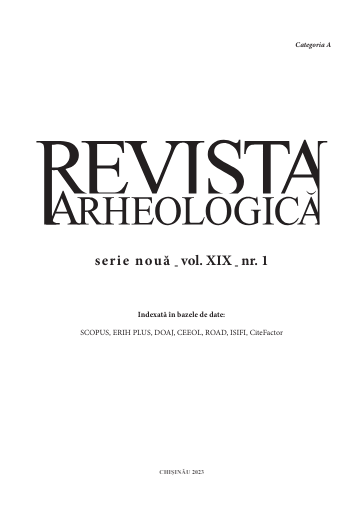O aşezare de tip Chişinău-Corlăteni din Câmpia Prutului de Mijloc (contribuţii la conturarea peisajului arheologic al satului Romanovca, r-nul Ungheni)
A Chişinău Corlăteni type settlement from the Middle Prut Plain (contributions to shaping the archaeological landscape of Romanovca village, Ungheni district)
Author(s): Irina RusuSubject(s): Archaeology, Cultural history, Regional Geography, Local History / Microhistory, Cultural Anthropology / Ethnology
Published by: Institutul Patrimoniului Cultural al Academiei de Științe a Moldovei
Keywords: Middle Prut Plain; Delia River; Romanovca; Precucuteni; Cucuteni; Noua; Chişinău-Corlăteni; Cozia-Saharna-Solonceni; Sântana de Mureş-Černjachov;
Summary/Abstract: In this article are presented the results of the field research carried out during the years 2021-2022 on the territory of the village of Romanovca (Ungheni district). The multi-layered settlement Romanovca I is located in the northwestern part of the village. The first level belongs to the Chişinău-Corlăteni culture (XII-X century BC), and the second to the Sântana de Mureş-Černjachov culture (III-V century AD). The C-C settlement, according to the distribution of the material, has a size of about 55 h and is part of the category of large settlements, geographically located on the slopes of the terrain near water sources. Within the C-C culture, we identified ceramic forms belonging to the Noua-Coslogeni. This fact, in the absence of stratigraphic data, may indicate, on the one hand, the succession of these two cultures in this settlement, on the other hand, some Bronze Age traditions at the beginning of the Iron Age. Also, a ceramic fragment was identified, which from the perspective of the decoration finds its analogies, both in the Belozerka culture and in the culture of the Middle Hallstatt, Cozia-Saharna-Solonceni. Unlike C-C, the specific settlement of SMČ, is mainly located on the right side of the water course. From the perspective of materiality, it does not differ from other similar settlements. Also in the northwestern part of the village, on Pârlitul hill, were discovered traces of two settlements. The first belongs to the Cucuteni culture, phase B, and the second to the Precucuteni culture. The settlements are located in close proximity, which is why we named them (Romanovca II). The Romanovca III site is located in the north-eastern part of the village, it has a size of about 1 h. Fragments belonging to the cultures: Cucuteni, C-C and SMČ were found on the surface. Finally, the Romanovca IV site, specific to the SMČ culture, is located in the southeastern part. The materials that was identified on the surface of the settlement, was not relevant for the reconstruction of some ceramic forms.
Journal: Revista Arheologică
- Issue Year: XIX/2023
- Issue No: 1
- Page Range: 69-86
- Page Count: 18
- Language: Romanian

